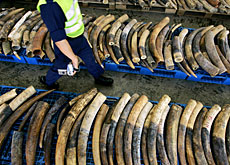
Ivory takes centre stage at species meeting

Switzerland would support the opening of a limited ivory trade – under certain conditions, says the Federal Veterinary Office.
The official position comes ahead of a major international conference on species protection at The Hague in the Netherlands, which started on Sunday.
A total of 171 countries are attending the Convention on International Trade in Endangered Species of Wild Fauna and Flora (Cites), which is held every three years.
The agreement, of which Switzerland is the depositary country, is aimed at achieving the sustainable use of the world’s wildlife. This includes ivory.
“Trade in ivory is a very sensitive subject that is very often emotional,” said Mathias Lörtscher, head of Cites management in Switzerland, who will be attending the two-week conference.
Animal protection organisations estimate that around 20,000 elephants are killed every year for their tusks.
Botswana and Namibia, which have large African Elephant populations, have submitted proposals to the conference calling for limited future sales in the product, with profits to be filtered back into elephant protection measures.
This is controversial as many people – including other African countries – believe that such a move would increase ivory poaching.
Easing the ban?
Cites banned the international commercial trade in ivory in 1989. However, several African countries were allowed to make a one-time sale in 1997.
A second sale was agreed in principle for Botswana, Namibia and South Africa in 2002.
This was on several conditions, including that the Mike programme (Monitoring of Illegal Killing of Elephants) had gathered enough baseline data on elephant killing to help determine what the effect of opening trade would be.
The sale has not yet taken place due to questions over the data gathering. The Cites standing committee will meet just before the conference begins to discuss the issue.
Lörtscher said that Switzerland believed it was a bit premature to open trade more before the one-off sale had taken place and the effects on poaching were known.
“We sympathise with these countries because they invest much in the protection of elephants and have elephant populations that are growing strongly and even cause problems,” said Lörtscher.
“They should be able to sell their ivory because the gains from that sale would go back to elephant protection, the problem is we don’t know whether this would have adverse effects [on the elephant population].”
Red tape
In terms of other proposals, Switzerland will support a European Union plan to cut red tape when it comes to the export and re-export of some Cites animal products, such as crocodile watch straps.
“The reporting requirements and the issuing of thousands of permits for these products have no conservation effect on the species. They are just bureaucracy,” said Lörtscher.
Last year Switzerland issued 87,000 re-export permits alone for its large watch industry.
But despite this Switzerland remains a champion of the agreement.
“Cites is a very important convention because it has teeth. It supports trade if it is sustainable. As soon as it is not, Cites can act, and it can say certain countries should not be traded with anymore for certain products or even not at all,” explained Lörtscher.
“It is proven that it works,” he added. “Crocodiles were highly protected at the beginning of Cites and now limited trade is possible.”
swissinfo, Isobel Leybold-Johnson
The Cites conference runs from June 3-15.
The Swiss delegation is made up of two people from the Veterinary Office, and one each from the Foreign Ministry and Environment Office.
In addition, the Veterinary Office’s director, Hans Wyss, will be attending Cites’s first ministerial debate, which has been organised by the Netherlands government, on June 13.
Cites was set up in 1973. It is an international agreement between governments that aims to ensure that international trade in specimens of wild animals and plants does not threaten their survival. It has 171 members.
Around 30,000 types of plants and animals are offered varying degrees of protection by the accord.
The international trade in wildlife is estimated to be worth billions of dollars annually and to involve more than 350 million plant and animal specimens every year.
Switzerland is the depositary state of Cites and the Cites secretariat is in Geneva.
Cites provides three regulatory options in the form of Appendices.
Appendix I: animals and plants are excluded from international commercial trade except in very special circumstances. Includes great apes, big cats such as cheetahs and tigers, and some orchids. Covers 530 animals and more than 300 plants.
Appendix II: trade is permitted but strictly controlled on the basis of Cites permits. Covers more than 4,460 animals and 28,000 plants.
Appendix III: includes species that are protected in a member country’s borders. By listing a species, a country calls for help in regulating the trade in the species. Covers more than 290 species.

In compliance with the JTI standards
More: SWI swissinfo.ch certified by the Journalism Trust Initiative




























You can find an overview of ongoing debates with our journalists here . Please join us!
If you want to start a conversation about a topic raised in this article or want to report factual errors, email us at english@swissinfo.ch.